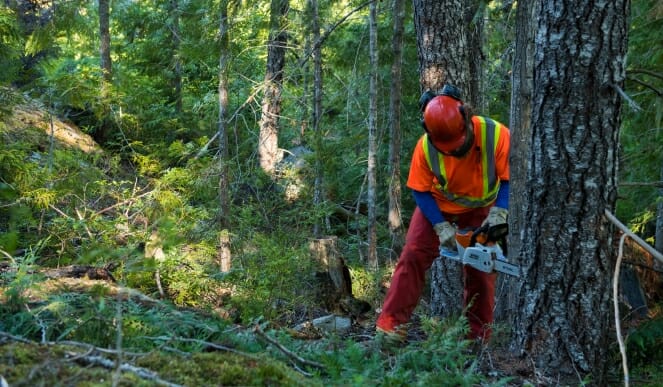The RMOW continues to implement the recommendations of its Community Wildfire Protection Plan and the 2016 Wildfire Protection Strategy as part of the overall wildfire management program. High priority locations for fuel thinning are identified in these plans and annual work plans are created. Fuel thinning is taking place in two locations this fall as part of Whistler’s ongoing efforts to reduce the risk of wildfire in the community. The wildfire crew has been working above Taluswood in recent weeks and will move to a site adjacent to Whistler Secondary School after Thanksgiving.
Fuel thinning in Taluswood began July 6, but was put on hold in late summer due to the high fire danger rating. Work has resumed and will continue Monday to Friday until October 8. Some biking and hiking trails on Whistler Mountain above Creekside are impacted while fuel thinning is completed. The crew will return in spring 2022 to complete the project.
Crews access the site by crossing the lower Dave Murray Downhill run. Access has been coordinated with Whistler Blackcomb staff and best efforts will be made to cross the trail outside of bike park hours. Bike park users are asked to please be aware and use caution while riding.
Insomnia trail (part of Whistler Mountain Bike Park) intersects in several locations with the project’s access route and may experience intermittent closures. View project updates.
On October 12, fuel thinning crews will begin treating areas near Whistler Secondary School Monday through Friday from 8 a.m. to 4 p.m. Work will take place between the high school and the Valley Trail as well as north of the school grounds. Closure of the Valley Trail will be required from the Rainbow neighborhood intersection to the Alpine Meadows intersection at Highway 99 and Alpine Way. Please use the Valley Trail on the west side of Highway 99. Information signs and fencing will be installed at key points to inform the public of the project and to restrict access from the active logging site. Barricades and signs will direct public to the Valley Trail detour. The project is expected to take one month to complete. View project details.
Learn more about these and other fuel reduction projects at whistler.ca/FuelThinning.
About fuel thinning in Whistler
There is a significant risk of large-scale wildfire within the Sea to Sky Corridor due to increasingly hotter, longer, drier summers and the increasing recreational use of the forested areas in the corridor. Fuel thinning is one part of Whistler’s wildfire protection program and helps to limit fire growth, reduce fire severity and aids in fire suppression efforts. This work reduces the risk of fire ignition and spread into the tree canopy by changing forest and fuel characteristics. Thinning trees in dense second growth forest areas encourages non-flammable vegetation to grow on the forest floor, while reducing the amount of fuel available to increase fire intensity and spread. Fuel thinning leaves the healthiest and largest trees untouched, and does not thin in old growth forests as they are naturally more wildfire resistant. Prior to treating areas, rare or endangered vegetation is identified and bird surveys are conducted. Learn more.

